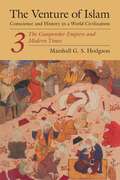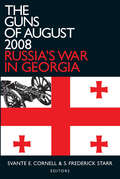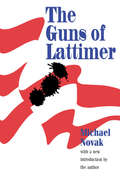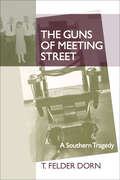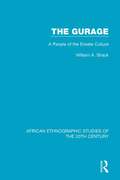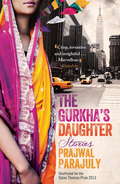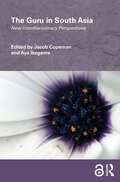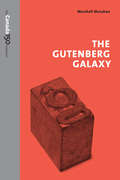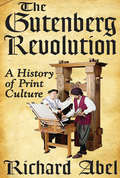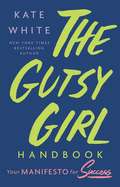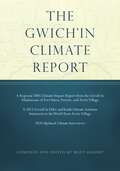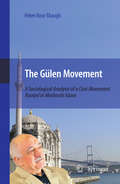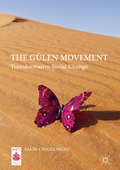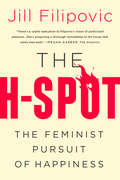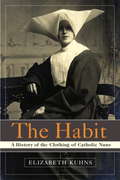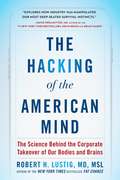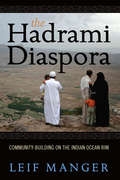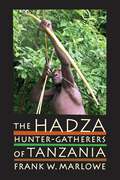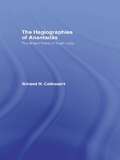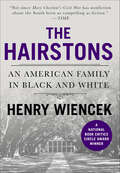- Table View
- List View
The Gunpowder Empires and Modern Times: The Gunpowder Empires And Modern Times (The Venture of Islam: Conscience and History in a World Civilization)
by Marshall G.S. HodgsonThe final installment in the groundbreaking The Venture of Islam series, &“a monumental three-volume interpretation of Islamic civilization&” (Review of Middle East Studies). The Venture of Islam has been honored as a magisterial work of the mind since its publication in early 1975. In this three-volume study, illustrated with charts and maps, Hodgson traces and interprets the historical development of Islamic civilization from before the birth of Muhammad to the middle of the twentieth century. This work grew out of the famous course on Islamic civilization that Hodgson created and taught for many years at the University of Chicago. In this concluding volume of The Venture of Islam, Hodgson describes the second flowering of Islam: the Safavi, Timuri, and Ottoman empires. The final part of the volume analyzes the widespread Islamic heritage in today&’s world.Praise for The Venture of Islam &“This is a nonpareil work, not only because of its command of its subject but also because it demonstrates how, ideally, history should be written.&” —The New Yorker &“In placing Islamic society in a context encompassing not only Islam outside the Middle East proper but contemporary societies such as western Europe and China, he provides a prospective sorely missed in most works on the subject.&” —Linda C. Rose, History
The Guns of August 2008: Russia's War in Georgia (Studies of Central Asia and the Caucasus)
by S. Frederick Starr Svante E. CornellIn the summer of 2008, a conflict that appeared to have begun in the breakaway Georgian territory of South Ossetia rapidly escalated to become the most significant crisis in European security in a decade. The implications of the Russian-Georgian war will be understood differently depending on one's narrative of what transpired and perspective on the broader context. This book is designed to present the facts about the events of August 2008 along with comprehensive coverage of the background to those events. It brings together a wealth of expertise on the South Caucasus and Russian foreign policy, with contributions by Russian, Georgian, European, and American experts on the region.
The Guns of August 2008: Russia's War in Georgia (Studies of Central Asia and the Caucasus)
by S. Frederick Starr Svante E. CornellIn the summer of 2008, a conflict that appeared to have begun in the breakaway Georgian territory of South Ossetia rapidly escalated to become the most significant crisis in European security in a decade. The implications of the Russian-Georgian war will be understood differently depending on one's narrative of what transpired and perspective on the broader context. This book is designed to present the facts about the events of August 2008 along with comprehensive coverage of the background to those events. It brings together a wealth of expertise on the South Caucasus and Russian foreign policy, with contributions by Russian, Georgian, European, and American experts on the region.
The Guns of Lattimer
by Michael NovakOn September 10, 1897, in the hamlet of Lattimer mines, Pennsylvania, an armed posse took aim and fired into a crowd of oncoming mine workers, who were marching in their corner of the coal-mining region to call their fellow miners out on strike. The marchers Poles, Slovaks, Hungarians, most of whom could not yet speak English were themselves armed only with an American flag and a timid, budding confidence in their new found rights as free men in their newly adopted country. The mine operators took another view of these rights and of the strange, alien men who claimed them. When the posse was done firing, nineteen of the demonstrators were dead and thirty-nine were seriously wounded. Some six months later a jury of their peers was to exonerate the deputies of any wrong-doing.This long-forgotten incident is here movingly retold by Michael Novak, himself the son of Slovak immigrants and one of our most gifted writers and social observers. In his hands, the so-called "Lattimer Massacre" becomes not only a powerful story in its own right (and an invaluable key to the history of the growth of the united mine Workers), but an allegory of that peculiarly American experience undergone over and over again throughout the land, and down to this very day; the experience of new immigrants, still miserable with poverty and bewilderment and suffering the trauma of culture shock, being confronted by the hostility and blind contempt of the "real" Americans.In Michael Novak's uniquely vivid account, the incident at Lattimer is seen as a tragedy brought on not so much by inhumanity as by the profound failure of majority WASP society to understand the needs and responses of "foreigners." The Guns of Lattimer is a gripping book that tells Americans, old and new, a great deal about themselves and the society they live in.
The Guns of Meeting Street: A Southern Tragedy
by T. Felder DornAn engrossing investigation into the true crime story of a sixteen-year family feud that ended in murder in early twentieth-century South Carolina.As compelling as fiction, The Guns of Meeting Street reconstructs a series of murders from the early 1940s that rocked rural Edgefield County, South Carolina. Featuring a cast of unlikely antagonists—a prominent store owner, an elementary school teacher, and a law enforcement officer—the acts of revenge resulted in five murders and a trio of executions, including that of the first woman to be electrocuted in South Carolina.Through interviews with members of the two families involved, T. Felder Dorn probes the longstanding feud between the Logues and the Timmermans to uncover this chilling plot of resentment, revenge, and violence. Dorn’s careful research weaves together the oral history of family members affected by the shooting with court transcripts, prisoner confessions, and coroners’ reports to produce a truly gripping account of the events.Although most of the deaths took place between 1940 and 1943, the roots of this tragedy can be traced back to killings that occurred in the Meeting Street community in the 1920s. The story climaxes on January 15, 1943, with the execution, within a single hour, of Sue Stidham Logue, George Logue, and Clarence Bagwell for the murder of Davis Timmerman. Dorn’s saga concludes with the 1960 parole and rehabilitation of Joe Frank Logue Jr., the only one of Timmerman’s killers to escape capital punishment.Not for the faint of heart, The Guns of Meeting Street details the circumstances and motivations for the killings, the complexities of the court cases, and the involvement in the proceedings of South Carolina governors Richard Manning Jefferies, Olin D. Johnston, and J. Strom Thurmond.“If you have any interest in history or true crime, The Guns of Meeting Street is a winner.” —Spartanburg Herald Journal“Dorn’s rigorously researched book unfolds in a clear, straightforward style that renders the events all the more disturbing.” —The State“Dorn’s extremely impressive book has all the elements—is fascinating in its entirety. And for every reader who loves a good mystery, The Guns of Meeting Street is available to intrigue, inform, incite and excite. It’ll never get a chance to gather dust on any bookshelf.” —Union (N.J.) Leader
The Gurage: A People of the Ensete Culture
by William A. ShackOriginally published in 1966 this study gives a detailed account of all aspects of Gurage life. An introductory chapter on South-West Ethiopia and the history of the area is followed by descriptions of Gurage settlements, ensete (banana-like plants) cultivation, kinship and marriage, the political system and religious organization. The author's fieldwork and discussions with many resident and migrant Gurage in Addis Ababa enabled him to provide a valuable account of a hitherto little known people and ethnographic area.
The Gurkha's Daughter: shortlisted for the Dylan Thomas prize
by Prajwal ParajulyA pioneering collection describing and dramatizing the Nepalese diaspora - the displacement and exile of the Nepali-speaking world*SHORTLISTED FOR THE DYLAN THOMAS PRIZE*A disfigured servant girl plans to flee Nepal; a Kalimpong shopkeeper faces an impossible dilemma; a Hindu religious festival in Darjeeling brings with it a sacrifice; a Nepali-Bhutanese refugee pins her hopes on the West; a Gurkha's daughter tries to comprehend her father's complaints; two young Nepali-speaking immigrants meet in Manhattan. These are just some of the stories of the people whose culture and language is Nepalese but who are dispersed to India, Bhutan and beyond. From every perspective and on every page, Prajwal Parajuly blends rich colour and vernacular to paint an eye-opening picture of a unique world and its people.
The Gurkha's Daughter: shortlisted for the Dylan Thomas prize
by Prajwal ParajulyA pioneering collection describing and dramatizing the Nepalese diaspora - the displacement and exile of the Nepali-speaking world*SHORTLISTED FOR THE DYLAN THOMAS PRIZE*A disfigured servant girl plans to flee Nepal; a Kalimpong shopkeeper faces an impossible dilemma; a Hindu religious festival in Darjeeling brings with it a sacrifice; a Nepali-Bhutanese refugee pins her hopes on the West; a Gurkha's daughter tries to comprehend her father's complaints; two young Nepali-speaking immigrants meet in Manhattan. These are just some of the stories of the people whose culture and language is Nepalese but who are dispersed to India, Bhutan and beyond. From every perspective and on every page, Prajwal Parajuly blends rich colour and vernacular to paint an eye-opening picture of a unique world and its people.
The Guru in South Asia: New Interdisciplinary Perspectives (Routledge/Edinburgh South Asian Studies Series)
by Aya Ikegame Jacob CopemanThis book provides a set of fresh and compelling interdisciplinary approaches to the enduring phenomenon of the guru in South Asia. Moving across different gurus and kinds of gurus, and between past and present, the chapters call attention to the extraordinary scope and richness of the social lives and roles of South Asian gurus. Prevailing scholarship has rightly considered the guru to be a source of religious and philosophical knowledge and mystical bodily practices. This book goes further and considers the social engagements and entanglements of these spiritual leaders, not just on their own (narrowly denominational) terms, but in terms of their diverse, complex, rapidly evolving engagements with ‘society’ broadly conceived. The book explores and illuminates the significance of female gurus, gurus from the perspective of Islam, imbrications of guru-ship and slavery in pre-modern India, connections between gurus and power, governance and economic liberalization in modern and contemporary India, vexed questions of sexuality and guru-ship, gurus’ charitable endeavours, the cosmopolitanism of gurus in contexts of spiritual tourism, and the mediation of gurus via technologies of electronic communication. Bringing together internationally renowned scholars from religious studies, political science, history, sociology and anthropology, The Guru in South Asia provides exciting and original new insights into South Asian guru-ship.
The Gutenberg Galaxy
by Marshall McluhanThe Gutenberg Galaxy catapulted Marshall McLuhan to fame as a media theorist and, in time, a new media prognosticator. Fifty years after its initial publication, this landmark text is more significant than ever before. Readers will be amazed by McLuhan's prescience, unmatched by anyone since, predicting as he did the dramatic technological innovations that have fundamentally changed how we communicate. The Gutenberg Galaxy foresaw the networked, compressed 'global village' that would emerge in the late-twentieth and twenty-first centuries -- despite having been written when black-and-white television was ubiquitous. This new edition of The Gutenberg Galaxy celebrates both the centennial of McLuhan's birth and the fifty-year anniversary of the book's publication. A new interior design updates The Gutenberg Galaxy for twenty-first-century readers, while honouring the innovative, avant-garde spirit of the original. This edition also includes new introductory essays that illuminate McLuhan's lasting effect on a variety of scholarly fields and popular culture. A must-read for those who inhabit today's global village, The Gutenberg Galaxy is an indispensable road map for our evolving communication landscape.
The Gutenberg Galaxy
by Marshall McluhanThe Gutenberg Galaxy catapulted Marshall McLuhan to fame as a media theorist and, in time, a new media prognosticator. Fifty years after its initial publication, this landmark text is more significant than ever before. Readers will be amazed by McLuhan’s prescience, unmatched by anyone since, predicting as he did the dramatic technological innovations that have fundamentally changed how we communicate. The Gutenberg Galaxy foresaw the networked, compressed ‘global village’ that would emerge in the late-twentieth and twenty-first centuries — despite having been written when black-and-white television was ubiquitous. This new edition of The Gutenberg Galaxy celebrates both the centennial of McLuhan’s birth and the fifty-year anniversary of the book’s publication. A new interior design updates The Gutenberg Galaxy for twenty-first-century readers, while honouring the innovative, avant-garde spirit of the original. This edition also includes new introductory essays that illuminate McLuhan’s lasting effect on a variety of scholarly fields and popular culture. A must-read for those who inhabit today’s global village, The Gutenberg Galaxy is an indispensable road map for our evolving communication landscape.
The Gutenberg Revolution: A History of Print Culture
by Richard AbelOne of the most puzzling lapses in accounts of the rise of the West following the decline of the Roman Empire is the casual way historians have dealt with Gutenberg's invention of printing. The cultural achievements that followed the fifteenth century, when the West moved from relative backwardness to remarkable, robust cultural achievement, would have been impossible without Gutenberg's gift and its subsequent widespread adoption across most of the world.Richard Abel follows the radical cultural impact of the printing revolution from the eighth century to the Renaissance, addressing the viability of the new Christian/Classical culture. Although this culture proved too fragile to endure, those who salvaged it managed to preserve elements of the Classical substance together with the Bible and all the writings of the Church Fathers. The cultural upsurge of the Renaissance (fourteenth to seventeenth centuries), which resulted in part from Gutenberg's invention, is a major focus of this book.Abel aims to delineate how the cultural revolution was shaped by the invention of printing. He evaluates its impact on the rapid reorientation and acceleration of the cultural evolution in the West. This book provides insight into the history of the printed word, the roots of modern-day mass book production, and the promise of the electronic revolution. It is an essential work in the history of ideas.
The Gutsy Girl Handbook: Your Manifesto for Success
by Kate WhiteBestselling author, professional speaker, and former editor-in-chief of Cosmopolitan, Kate White shares the nine core principles gutsy women need to go bigger, bolder, and achieve the full level of success they desire.Twenty-two years ago Kate White wrote the bestselling career bible Why Good Girls Don't Get Ahead but Gutsy Girls Do, and helped thousands of women push their success to the next level. Now a new generation of women, still eyeing the pay gap and glass ceiling, needs its own set of rules for today's modern workplace.In THE GUTSY GIRL HANDBOOK White presents the nine core principles that have guided her career, offering dozens of straightforward, doable strategies for women in any field and at any stage in their professional lives. Drawing on original research, and sharing new success stories and never-before told examples from her time as the editor-in-chief of Cosmo, White inspires women to own their excellence, break the rules (or make their own), ask for the money and opportunities they deserve, and refuse to apologize for who they are and what they want. THE GUTSY GIRL HANDBOOK is a resource for women who want to build confidence, negotiate a great salary and perks, manage meetings, mansplaining, and interruptions, and create game-changing "notice me" ideas. This all-new, accessible handbook is a great gift for graduates, and a must-read for professional women of all levels.
The Guy's Guide to Feminism
by Michael Kimmel Michael KaufmanIn just one generation, age-old ideas about women have been swept aside . . . but what does that have to do with men? Authors Michael Kaufman and Michael Kimmel, two of the world’s leading male advocates of gender equality, believe it has everything to do with them-and that it’s crucial to educate men about feminism in order for them to fully understand just how important and positive these changes have been for them. Kaufman and Kimmel address these issues in The Guy’s Guide to Feminism. Hip and accessible, it contains nearly a hundred entries-from “Autonomy” to “Zero”-written in varying tones (humorous, satirical, irreverent, thoughtful, and serious) and in many forms (“top ten” lists, comics, interviews, mini-stories, and more). Each topic celebrates the ongoing gains that are improving the lives of women and girls-and what that really means for men. Informal and fun yet substantive and intelligent, The Guy’s Guide to Feminism illustrates how understanding and supporting feminism can help men live richer, fuller, and happier lives.
The Gwich’in Climate Report
by Matt GilbertA regional climate impact and adaptation report from the Gwich'in Athabascans of Interior Alaska, The Gwich’in Climate Report is a compilation of transcribed interviews between Matt Gilbert and northern Alaska Gwich’in Athabascan community members, elders, hunters, and trappers. The book explores Gwich’in insight and wisdom about ecology, climate, and the drastic effects of climate change on their landscapes and culture. These interview subjects are at a “ground zero” of climate change, and their voices are largely absent from popular research on and discussion of the topic. Their traditional knowledge of Arctic flora and fauna, forestation, landforms, meteorology, airstream behavior, and river hydrology makes a significant contribution to the documentation of climate change. In addition, Gilbert bridges the Gwich’in worldview and that of Western science by including factual substantiation and citations that corroborate key observations in the Gwich’in transcripts. A text that matters for its cultural and historical significance—as well as its potential impact on the way science and policy are conducted in rural Alaska and on public lands—TheGwich’in Climate Report will be of interest to residents of and stakeholders in the communities it represents as well as researchers concerned with on-the-ground conditions of ecosystems and Indigenous peoples most directly affected by climate change.
The Gülen Movement
by Helen Rose EbaughThis is a book about an Islamic movement, the Gülen Movement, that is rooted in a moderate version of Islam and that promotes interfaith and intercultural dialog and global peace. Based on interviews with supporters of the movement in Turkey and in the U.S. and visits to Gülen-inspired schools, hospitals, newspapers and relief organizations, the book describes a movement that has millions of supporters in Turkey and that has spread to over 100 countries on five continents.
The Gülen Movement: Transformative Social Change (Middle East Today)
by Salih CıngıllıoğluThis book presents findings from research into one of the world's most influential Islamic movements, the Gülen Movement, from the perspective of social transformation through adult education. At the core of research questions lies how the movement enrolls volunteers from all walks of life and transforms them to adopt its aims at the expense of their individual ideals. The book reveals the socio-psychological mechanisms that make such transformation possible by looking at how followers integrate weekly lectures and discussions on the theory and practice of Islam into their personal and social lives. The Gülen Movement offers a moderate interpretation of Islam and stresses the vitality of establishing communication with the members of all faiths. This book provides a window into how and why religion may roll into extremism by presenting findings from an opposite perspective: the participants in the research all define themselves as truly pious but do not even imply an act of violence in tens of hours of interviews. In short, the book weaves the strands of "Islamic," "movement," and "adult education" into a unified whole and limns the snapshot of a social movement, offering a comprehensive discussion of the role of adult education within the movement, as well as its transformative potential and its wider social and political implications.
The H-Spot: The Feminist Pursuit of Happiness
by Jill FilipovicWhat do women want? The same thing men were promised in the Declaration of Independence: happiness, or at least the freedom to pursue it.For women, though, pursuing happiness is a complicated endeavor, and if you head out into America and talk to women one-on-one, as Jill Filipovic has done, you see that happiness is indelibly shaped by the constraints of gender, the expectations of feminine sacrifice, and the myriad ways that womanhood itself differs along lines of race, class, location, and identity.In The H-Spot, Filipovic argues that the main obstacle standing in-between women and happiness is a rigged system. In this world of unfinished feminism, men have long been able to "have it all" because of free female labor, while the bar of achievement for women has only gotten higher. Never before have women at every economic level had to work so much (whether it's to be an accomplished white-collar employee or just make ends meet). Never before have the standards of feminine perfection been so high. And never before have the requirements for being a "good mother" been so extreme. If our laws and policies made women's happiness and fulfillment a goal in and of itself, Filipovic contends, many of our country's most contentious political issues-from reproductive rights to equal pay to welfare spending-would be swiftly resolved.Filipovic argues that it is more important than ever to prioritize women's happiness-and that doing so will make men's lives better, too. Here, she provides an outline for a feminist movement we all need and a blueprint for how policy, laws, and society can deliver on the promise of the pursuit of happiness for all.
The Habit: A History of the Clothing of Catholic Nuns
by Elizabeth KuhnsCuriosity about nuns and their distinctive clothing is almost as old as Catholicism itself. The habit intrigues the religious and the nonreligious alike, from medieval maidens to contemporary schoolboys, to feminists and other social critics. The first book to explore the symbolism of this attire, The Habit presents a visual gallery of the diverse forms of religious clothing and explains the principles and traditions that inspired them. More than just an eye-opening study of the symbolic significance of starched wimples, dark dresses, and flowing veils, The Habit is an incisive, engaging portrait of the roles nuns have and do play in the Catholic Church and in ministering to the needs of society.From the clothing seen in an eleventh-century monastery to the garb worn by nuns on picket lines during the 1960s, habits have always been designed to convey a specific image or ideal. The habits of the Benedictines and the Dominicans, for example, were specifically created to distinguish women who consecrated their lives to God; other habits reflected the sisters' desire to blend in among the people they served. The brown Carmelite habit was rarely seen outside the monastery wall, while the Flying Nun turned the white winged cornette of the Daughters of Charity into a universally recognized icon. And when many religious abandoned habits in the 1960s and '70s, it stirred a debate that continues today.Drawing on archival research and personal interviews with nuns all over the United States, Elizabeth Kuhns examines some of the gender and identity issues behind the controversy and brings to light the paradoxes the habit represents. For some, it epitomizes oppression and obsolescence; for others, it embodies the ultimate beauty and dignity of the vocation.Complete with extraordinary photographs, including images of the nineteenth century nuns' silk bonnets to the simple gray dresses of the Sisters of Social Service, this evocative narrative explores the timeless symbolism of the habit and traces its evolution as a visual reflection of the changes in society.From the Hardcover edition.
The Hacking of the American Mind: The Science Behind the Corporate Takeover of Our Bodies and Brains
by Robert H. Lustig"Explores how industry has manipulated our most deep-seated survival instincts."—David Perlmutter, MD, Author, #1 New York Times bestseller, Grain Brain and Brain MakerThe New York Times–bestselling author of Fat Chance reveals the corporate scheme to sell pleasure, driving the international epidemic of addiction, depression, and chronic disease. While researching the toxic and addictive properties of sugar for his New York Times bestseller Fat Chance, Robert Lustig made an alarming discovery—our pursuit of happiness is being subverted by a culture of addiction and depression from which we may never recover. Dopamine is the “reward” neurotransmitter that tells our brains we want more; yet every substance or behavior that releases dopamine in the extreme leads to addiction. Serotonin is the “contentment” neurotransmitter that tells our brains we don’t need any more; yet its deficiency leads to depression. Ideally, both are in optimal supply. Yet dopamine evolved to overwhelm serotonin—because our ancestors were more likely to survive if they were constantly motivated—with the result that constant desire can chemically destroy our ability to feel happiness, while sending us down the slippery slope to addiction. In the last forty years, government legislation and subsidies have promoted ever-available temptation (sugar, drugs, social media, porn) combined with constant stress (work, home, money, Internet), with the end result of an unprecedented epidemic of addiction, anxiety, depression, and chronic disease. And with the advent of neuromarketing, corporate America has successfully imprisoned us in an endless loop of desire and consumption from which there is no obvious escape. With his customary wit and incisiveness, Lustig not only reveals the science that drives these states of mind, he points his finger directly at the corporations that helped create this mess, and the government actors who facilitated it, and he offers solutions we can all use in the pursuit of happiness, even in the face of overwhelming opposition. Always fearless and provocative, Lustig marshals a call to action, with seminal implications for our health, our well-being, and our culture.
The Hadrami Diaspora: Community-Building on the Indian Ocean Rim
by Leif MangerThe Hadramis of South Yemen and the emergence of their diasporic communities throughout the Indian Ocean region are an intriguing facet of the history of this region’s migratory patterns. In the early centuries of migration, the Yemeni, or Hadrami, traveler was both a trader and a religious missionary, making the migrant community both a “trade diaspora” and a “religious diaspora.” This tradition has continued as Hadramis around the world have been linked to networks of extremist, Islamic-inspired movements—Osama bin Laden, leader of Al Qaeda and descendant of a prominent Hadrami family, as the most infamous example. However, communities of Hadramis living outside Yemen are not homogenous. The author expertly elucidates the complexity of the diasporic process, showing how it contrasts with the conventional understanding of the Hadrami diaspora as an unchanging society with predefined cultural characteristics originating in the homeland. Exploring ethnic, social, and religious aspects, the author offers a deepened understanding of links between Yemen and Indian Ocean regions (including India, Southeast Asia, and the Horn of Africa) and the emerging international community of Muslims.
The Hadza: Hunter-Gatherers of Tanzania
by Frank W. MarloweThe Hadza, who inhabit an area of East Africa near the Serengeti and Olduvai Gorge, have long drawn the attention of anthropologists and archaeologists for maintaining a foraging lifestyle in a region that is key to understanding human origins.
The Hadza: Hunter-Gatherers of Tanzania (Origins of Human Behavior and Culture #3)
by Frank MarloweIn The Hadza, Frank Marlowe provides a quantitative ethnography of one of the last remaining societies of hunter-gatherers in the world. The Hadza, who inhabit an area of East Africa near the Serengeti and Olduvai Gorge, have long drawn the attention of anthropologists and archaeologists for maintaining a foraging lifestyle in a region that is key to understanding human origins. Marlowe ably applies his years of research with the Hadza to cover the traditional topics in ethnography—subsistence, material culture, religion, and social structure. But the book’s unique contribution is to introduce readers to the more contemporary field of behavioral ecology, which attempts to understand human behavior from an evolutionary perspective. To that end, The Hadza also articulates the necessary background for readers whose exposure to human evolutionary theory is minimal.
The Hagiographies of Anantadas: The Bhakti Poets of North India
by Winnand CallewaertAnantadas is the first 'biographer' who, around 1600, wrote about the most popular bhakti poets of the 15th and 16th centuries in Northern India. This critical study of these manuscripts yields a broad spectrum of the linguistic and morphological variants. It also reveals the processes of oral and scribal transmission during this time when sectarian interests appropriated certain poets and changed their 'biographies' accordingly.
The Hairstons: An American Family in Black and White
by Henry WiencekThis “lovingly detailed history” chronicles the largest slaveholding family in the Old South, as its descendants—white and Black—grapple with its legacy (The Dallas Morning News).A National Book Critics Circle Award WinnerSpanning two centuries of one family’s history, The Hairstons tells the extraordinary story of the Hairston clan, once the wealthiest family in the Old South and the largest slaveholder in America. With several thousand black and white members, the Hairstons of today share a complex and compelling history: divided in the time of slavery, they have come to embrace their past as one family.For seven years, journalist Henry Wiencek combed the far-reaching branches of the Hairston family tree to piece together the experiences of both plantation owners and their slaves. Crisscrossing the old plantation country of Virginia, North Carolina, and Mississippi, The Hairstons reconstructs the triumphant rise of the remarkable children, grandchildren, and great-grandchildren of the enslaved as they fought to take their rightful place in mainstream America. It also follows the white descendants through the decline and fall of the Old South, and uncovers the hidden history of slavery’s curse—and how that curse followed slaveholders for generations.
